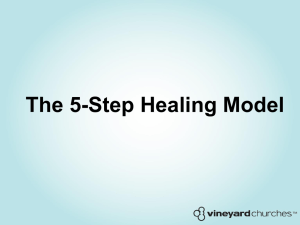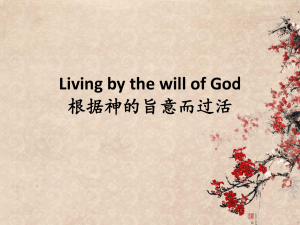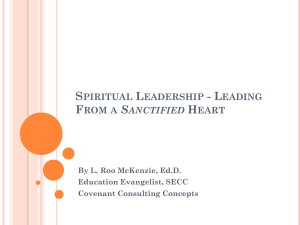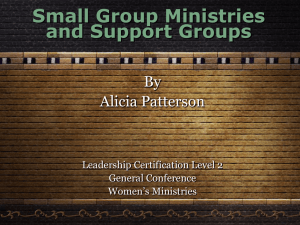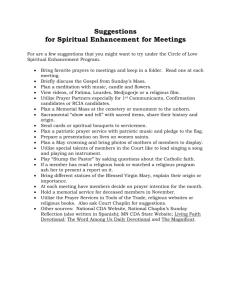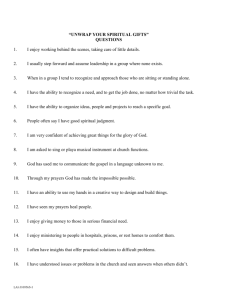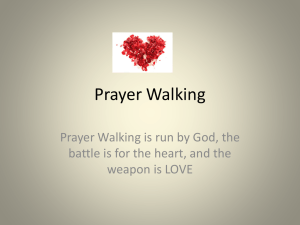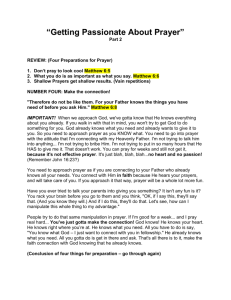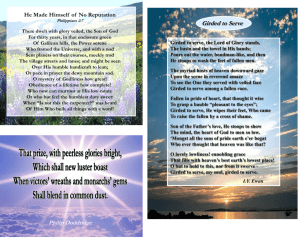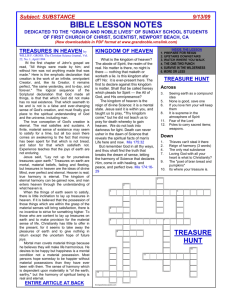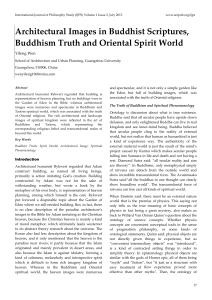Rectors Report 2011.1 - St Mary Magdalen Bermondsey
advertisement
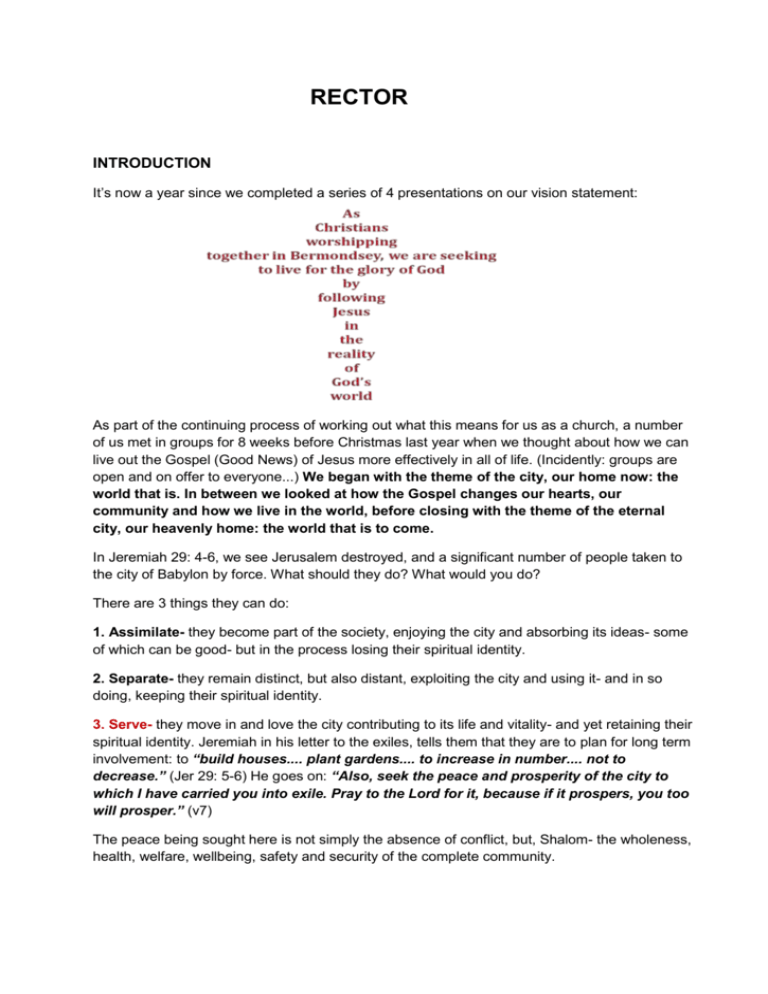
RECTOR INTRODUCTION It’s now a year since we completed a series of 4 presentations on our vision statement: As part of the continuing process of working out what this means for us as a church, a number of us met in groups for 8 weeks before Christmas last year when we thought about how we can live out the Gospel (Good News) of Jesus more effectively in all of life. (Incidently: groups are open and on offer to everyone...) We began with the theme of the city, our home now: the world that is. In between we looked at how the Gospel changes our hearts, our community and how we live in the world, before closing with the theme of the eternal city, our heavenly home: the world that is to come. In Jeremiah 29: 4-6, we see Jerusalem destroyed, and a significant number of people taken to the city of Babylon by force. What should they do? What would you do? There are 3 things they can do: 1. Assimilate- they become part of the society, enjoying the city and absorbing its ideas- some of which can be good- but in the process losing their spiritual identity. 2. Separate- they remain distinct, but also distant, exploiting the city and using it- and in so doing, keeping their spiritual identity. 3. Serve- they move in and love the city contributing to its life and vitality- and yet retaining their spiritual identity. Jeremiah in his letter to the exiles, tells them that they are to plan for long term involvement: to “build houses.... plant gardens.... to increase in number.... not to decrease.” (Jer 29: 5-6) He goes on: “Also, seek the peace and prosperity of the city to which I have carried you into exile. Pray to the Lord for it, because if it prospers, you too will prosper.” (v7) The peace being sought here is not simply the absence of conflict, but, Shalom- the wholeness, health, welfare, wellbeing, safety and security of the complete community. The peace, we pray for every Thursday at the C4T (Christians for Transformation) prayer meeting. It’s a peace which takes time to realise... The Architect Christopher Wren once asked a number of men working on his masterpiece- St Paul’s- What are you building? One man said a wall, another, an arch, another, a window.... A fourth said, “a cathedral.” That man had a long term vision for what he was doing: for something of beauty which would last. For Christopher Wren too: the Cathedral was a lifetime’s work, and so too can be life in the city, if we seriously ask God why he has called us here. This of course, is not simply about buildings. As the “Statement of Need” which was included in the Faculty application for the new work on St Mary’s says: “We believe this to be not only physical but also spiritual.” A couple of weeks ago, on the C4T prayer walk around Bermondsey and Rotherhithe, I was reminded of a similar walk around our parish about 5 years ago. We walked near the exposed walls of Bermondsey Abbey (now built over on the Square). When we reflect on layer upon layer of human history in this place- the good and the bad- it helps for us to: 1. Recognize the reality of the spiritual realm. If things change there, then they will also change here. As Jesus said to Peter “I will give you the keys of the kingdom of heaven; whatever you bind on earth will be bound in heaven, and whatever you loose on earth will be loosed in heaven.” (Matthew 16: 18-19) Heaven and earth are connected through us, God’s people, and that calls us to: 2. Engage both with the sorrow of the past and the hope we have in God for the future. Now as then, we reflect on the words of Nehemiah 1: 3b-4. “.....’The wall of Jerusalem is broken down, and its gates have been burned with fire’ When I heard these things, I sat down and wept. For some days I mourned and fasted and prayed before the God of heaven.” When we engage we also: 3. Listen to God and allow the Holy Spirit to direct where and how we should pray. Listening leads us to: 4. Identify, as part of the community, with all that has gone wrong and in confessing on behalf of previous generations, also acknowledge our own need for forgiveness. “...let your ear be attentive and your eyes open to hear the prayer your servant is praying before you day and night for your servants, the people of Israel. I confess the sin we Israelites, including myself and my father’s house, have committed against you. We have acted very wickedly toward you.....” (Nehemiah 1: 6-7b). Finally, we can: 5. Renounce the powers of darkness and be released from past failures.... Someone once said to me that this church is “here for good” That means you are here for good! Whatever your reason for being here: May be your job has brought you, or you are a student. May be you are here because of a partner or other family members. Perhaps you are on your way somewhere else? But, what if you have been sent? When Jesus prayed to his Father, for his disciples, he said: “As you sent me into the world, I have sent them....” If we have been sent, then Why? In the first few months of this year, we have been meeting to worship and pray on Sunday evenings in church. I believe God has guided us to explore a number of different but related themes. 1. Walls breaking down: The actual breaking down of walls is a helpful metaphor for what God is doing: In us, between us and between us and others. I believe God has called me to break down walls. Will you join me? 2. A new house is being built: “Who of you is left who saw this house in its former glory? How does it look to you now? Does it not seem to you like nothing?” (Haggai 2: 3) The people are called to be strong and work, because the time is right. “The glory of this present house will be greater than the glory of the former house...and in this place I will grant peace..” (Haggai 2:9a) 3. A River will flow out from this house: “Then the angel showed me the river of the water of life, as clear as a crystal, flowing from the throne of God and of the Lamb down the middle of the great street of the city. On each side of the river stood the tree of life, bearing twelve crops of fruit, yielding its fruit every month. And the leaves of the tree are for the healing of the nations. (Revelation 22: 1-3a) 1. 2. 3. CONCLUSION As I conclude, I would like to share a picture given to someone at the beginning of the Prayer walk. It was of the Shard, by London Bridge, soon to be the tallest building in Europe: inverted and pointing, not up, but down as a funnel for God’s power and love, flowing into Bermondsey. At certain key points on the Walk, we finished our prayers by celebrating Holy Communion. By Breaking of Bread and drinking of wine together, we share in Christ’s supreme act of identification with a broken world. Will we serve the city? Will we identify with our community? Will we break down walls so that God’s spirit can flow from heaven and out like a river into our world? “No longer will there be any curse. The throne of the Lamb will be in the city and his servants will serve him.” (Revelation 22: 3b) Revd Charlie Moore April 2011
